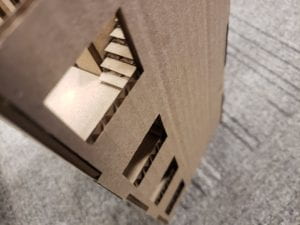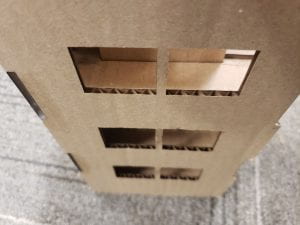GRADE 9
The Salmon Project

[Above] The fish ladder model I created for the Salmon Project. Used clay, store-bought trees, and paint.
The Salmon Project was a fun, short project about spreading awareness about the problems salmon face, and inventing new devices to encourage a convenient lifestyle for these fish. My contribution to this project was constructing a diorama showcasing the fish ladder, which can be found next to dams in different variations. This project was fun to create using my hands only. I always considered creating objects with my hands as a hobby (arts and crafts).
Sustainable City Project
Probably one of the most ambitious projects I will be completing at my time in STEAM 9. This project involves designing a city with a “sustainable” aspect, such as a dam or recycling facility. Once the design of the entire city is completed, I am required to build it through Minecraft. It was exciting to build my dream city.
Here are some pictures of my city:
 The beach in my city.
The beach in my city.
 A building at the Port/Harbour of my city.
A building at the Port/Harbour of my city.
 Another picture of the building at the Port/Harbour.
Another picture of the building at the Port/Harbour.
 Dam in the city.
Dam in the city.
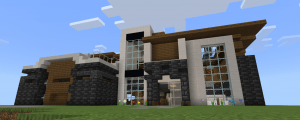 Sustainable house I made.
Sustainable house I made.
Point Perspective Drawings
One Point Drawing
Drawing of a road and a small building beside it.
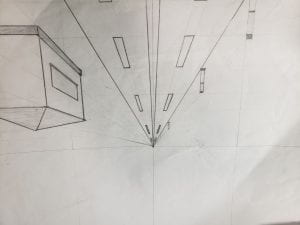
Two Point Drawing
Drawing of a castle with three towers. (I dont know how to rotate images)

Three Point Drawing
Drawing of a residency with a tree and bushes in it.

GRADE 10
Perspective Drawings
One-Point Drawing
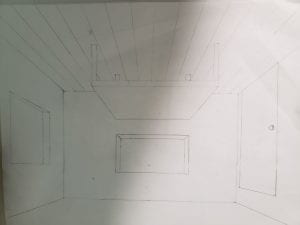
Followed the instructions from the one-point drawing tutorial. Nothing special or unique about my drawing. (Don’t know why these images are upside down, they shouldn’t be. I took the pictures the right way.)
Two-Point Drawing
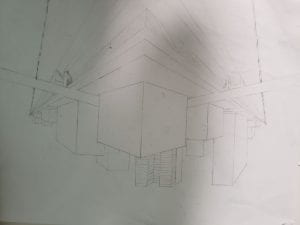
Followed the instructions from the two-point drawing tutorial. Again, I have made no attempt to make it unique or add any other qualities. I only used these drawings to practice creating straight and proportionate drawings.
Four-Point Drawing

Looks similar to the drawing made in the video tutorial for the four-point drawing. Though, I’ve made the effort to shade objects, some trees, and add a sewer entrance.
Isometric Drawing
Isometric Drawing featuring the “STEAM” logo.
Choice Drawing
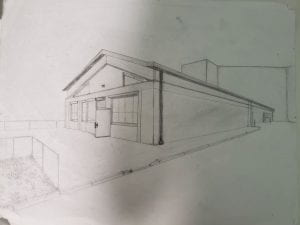
My most proudest and favourite drawing of all the point perspective drawings. This drawing I have put all my practice from the other drawings and drew a picture representing a portion of the school. Although the photo quality is terrible, and details can’t be seen easily, I have shaded walls and added detailed grass, drawing each blade of grass.
Maze Project

The maze project uses AutoCad to create a maze with a theme. I chose my maze to have a theme of the minions.
Gravity Car Project
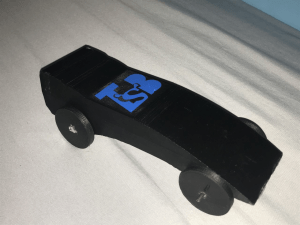
The gravity car project combined aspects of the physics unit and drafting. As its name implies, the class was to create cars, which would be only moved by gravity/potential energy by releasing it on a ramp. The car shown in the picture is the gravity car my group has created. It has a 3d printed body/chassis, made through Inventor. Its wheels are also 3d printed, while its axels are thin copper rods. The car has a sticker, representing the group name, TSB (Tei Sebastien Brendan), and it had a laser cut wooden spoiler. Unfortunately, the car’s spoiler was destroyed while left in the drafting class over the weekend.
Litt Launcher project

The Litt Launcher project involves the design of a launcher and a projectile(s) for each person in a group. One catcher for the group would be made for the launcher to shoot the projectiles into. For my launcher, I made a spring-powered launcher that requires the spring to be pulled back and let go to launch the projectile. One thing I like about my launcher is its diversity in its projectile. It can shoot anything that can fit in the barrel, such as a marble or battery. This ability to shoot almost any projectile introduces a recycled material aspect. For example, used batteries can be used as projectiles (they can be used as a projectile rather than it being thrown out in the garbage).
Individual Score: 767
Group Average: 1093
Video:
Ping Pong Pickup Challenge
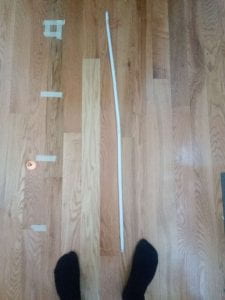

Activity hosted by the Science Buddies Organization
The Ping Pong Pickup Challenge is a competition hosted by the Science Buddies organization. Using paper, strings, or some other materials, tools must be constructed with the purpose of picking up a ping pong from the longest distance possible. In a cooperative effort to build the tool with a friend, we have constructed a tool that uses a string to fasten the ball. I have introduced the idea and helped in the prototyping of this tool. The construction of the final version of the tool was done by my colleague.
Video: 20230321_161256.mp4
STEAM 9 Tower | Staircase and Elevator


The STEAM Tower was a project undertaken by the two STEAM 9 cohorts, all collaborating on the construction of a sustainable building as a living space. I would contribute to the tower through the production of a staircase and elevator compartment, which would be fitted alongside the tower. Time spent on this project was distributed through my first semester, while I was volunteering for the STEAM 9 cohorts, and the time allocated to students during the Capstone Project.
The Designs for the Staircases
For the duration of producing the staircase and elevator for the tower, designing and creating the staircases took up the most time. At first, it seemed simple, yet the process of determining a design that could be easily produced multiple times and gluing each part posed difficulty. Two design proposals for the staircases were considered in the project, both utilized the Laserbox cutter:
Folding Cardboard into a Shape of a Staircase
The first prototype for the staircase was created on the search for a simple solution. For the first week, attempts were made to produce a staircase from folding cardboard. The laser cutter would be used to cut out a long rectangular shape considering the height and length of each step in determining the length of the shape. Light incisions into the surface of the cardboard was made in an attempt to make the folding of the material easier. These cuts would be made at “fold points”, the point at which the cardboard is to be folded. After attempting to implement this design, and trying to fold the cardboard into a staircase shape, it was decided that the design was flawed due to several factors:
- Cardboard has multiple layers with two sheets of cardboard held together by fluting. An incision (that does not cut all-the-way through) separates these layers and creates difficulty in folding the material. The material has to be “one” in order to be folded correctly.
- The process of folding takes too much time to create a product that does not resemble a staircase.
- The shape is not rigid and easily malleable. Folding the cardboard destroys the layer of fluting and becomes easily malleable. It will not hold its shape.
Dollhouse Stairs
Following inspiration from a video online covering the production of a staircase for a dollhouse, a design, involving the staircase to be composed of multiple shapes, was considered and would be eventually used. The pieces used to construct the staircase would be composed of:
- Side pieces
- Steps
- Pieces for the bottom of the stairs
By laser-cutting each piece out and gluing them together, the shape of a staircase can be formed. Throughout the period of “perfecting” the dollhouse stair design, I’ve encountered difficulty and went through multiple prototypes as a result.
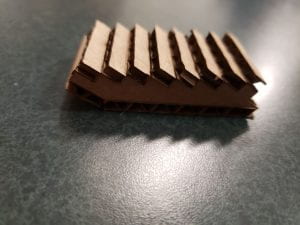
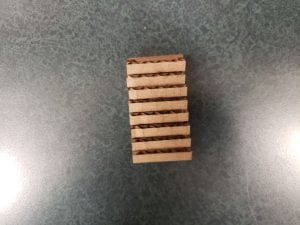
First prototype of dollhouse staircase design. The staircase had no lip on the top stair to allow for the stairs to easily fit with the top floor section. The stairs were too wide.
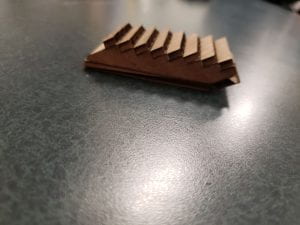
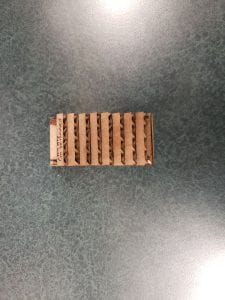
Second prototype of dollhouse staircase design. The staircase now had a lip for the stairs to easily grip onto the top floor. However, the stairs were too wide and the steps were too tall.

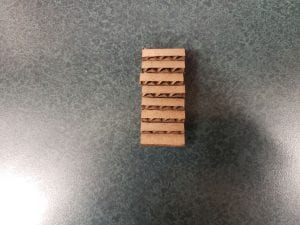
Finished product using the dollhouse staircase design. Stairs are smaller and can be fit inside the stairwell with ease.
Walls and Elevator Shaft
The walls and elevator shaft are straight-forward in design. The exterior walls have several windows and doorways. The stairway revolve around the elevator shaft, which is in the middle. This configuration allows both elevator and stairway to remain in the same room without taking more unnecessary space.
